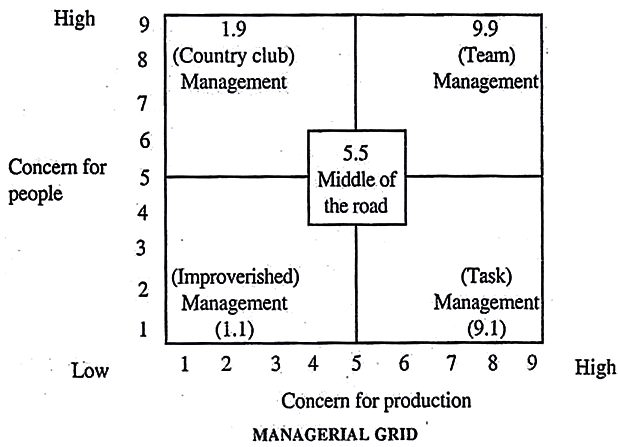Managerial Grid Theory was developed by Robert Blake and Jane Mouton in the early 1960s to analyze leadership styles based on two key dimensions: Concern for People and Concern for Production. This theory is also known as the Leadership Grid. The primary objective of the theory is to help managers understand their inherent style of leadership and provide a framework for improving it.
Blake and Mouton’s grid identifies five distinct leadership styles, placing them on a grid with concern for production on the X-axis and concern for people on the Y-axis. The concern for production refers to task orientation or the focus on achieving organizational goals, while concern for people refers to relationship orientation or how leaders interact with subordinates.
Key Dimensions of the Managerial Grid:
-
Concern for People (Y-axis):
This dimension reflects the degree to which a leader considers the well-being, personal needs, interests, and development of subordinates when making decisions. A high concern for people indicates a leader who prioritizes employee satisfaction and morale.
- Concern for Production (X-axis):
This dimension indicates the extent to which a leader emphasizes productivity, efficiency, and goal attainment. A high concern for production signifies a results-oriented leader who focuses on achieving organizational objectives.
In 1999, the grid managerial seminar began using a new text, The Power to Change.

Five Leadership Styles:
Blake and Mouton proposed five key leadership styles based on different combinations of concern for people and concern for production:
-
Impoverished Management (1,1): Low Concern for People, Low Concern for Production
This style represents minimal effort by the manager, both in terms of task accomplishment and people management. Leaders who exhibit this style tend to avoid responsibility and have little commitment to achieving results or ensuring employee well-being. The result is low productivity and low morale.
Example: A manager who only performs the bare minimum and avoids engaging with employees or improving processes.
-
Task Management (9,1): Low Concern for People, High Concern for Production
Also known as Authoritarian or Dictatorial Style, this approach emphasizes high productivity with little regard for employees’ needs or morale. Leaders using this style focus solely on achieving goals, often at the expense of employee satisfaction. While short-term results may be high, long-term morale and engagement suffer.
Example: A factory manager who prioritizes output without considering employee fatigue or motivation.
- Country Club Management (1,9): High Concern for People, Low Concern for Production
This style focuses on creating a friendly and comfortable work environment, with little emphasis on task achievement. While employees may feel valued and satisfied, this approach often results in low productivity due to a lack of direction and control.
Example: A manager who emphasizes social gatherings and employee comfort but neglects deadlines and performance metrics.
-
Middle-of-the-Road Management (5,5): Moderate Concern for People, Moderate Concern for Production
This style represents a balance between concern for people and concern for production. Leaders using this style try to achieve acceptable performance levels while maintaining reasonable employee satisfaction. However, this compromise often leads to mediocre results in both areas.
Example: A manager who tries to please everyone and achieves moderate results without excelling in either productivity or employee engagement.
-
Team Management (9,9): High Concern for People, High Concern for Production
Considered the ideal leadership style, Team Management emphasizes both high productivity and high employee morale. Leaders adopting this style foster a collaborative environment, encourage participation, and focus on achieving high performance while ensuring employee well-being. This approach often results in high job satisfaction, innovation, and sustained productivity.
Example: A project manager who involves the team in decision-making, provides clear direction, and supports employee growth while meeting deadlines effectively.
Advantages of the Managerial Grid Theory:
-
Simple and Practical Framework:
The theory provides a straightforward way to analyze leadership styles by focusing on two key dimensions, making it easy for managers to understand and apply.
-
Diagnostic Tool for Self-Assessment:
Managers can use the grid to assess their current leadership style and identify areas for improvement.
-
Emphasizes Balance:
By highlighting the importance of balancing concern for people and production, the theory encourages a holistic approach to leadership.
-
Promotes Team-Oriented Leadership:
The Team Management style (9,9) is presented as the ideal, encouraging leaders to strive for both high productivity and employee satisfaction.
Criticism of the Managerial Grid Theory:
- Over-Simplification of Leadership:
Critics argue that reducing leadership to two dimensions may oversimplify the complexities of real-world leadership, where multiple factors such as situational dynamics and organizational culture play crucial roles.
- Ignores Situational Factors:
The theory assumes that the same leadership style is effective in all situations. However, contingency theories suggest that the best leadership style depends on specific situational variables.
- Limited Emphasis on External Influences:
The theory focuses mainly on internal leadership behavior, without considering external factors such as market conditions, technological changes, and competitive pressures.
- Ideal Style Not Always Practical:
While the Team Management style (9,9) is presented as ideal, it may not always be feasible in every organization due to resource constraints or other limitations.
Practical Implications for Managers:
Managers can use the Managerial Grid as a tool to reflect on their leadership style and make necessary adjustments. For example, a manager who realizes they have a high concern for production but a low concern for people (9,1) may work on developing better interpersonal relationships with their team. Similarly, those who prioritize people over production (1,9) can focus on improving task management skills.
Training programs based on the Managerial Grid can help managers develop a balanced approach to leadership, fostering both employee satisfaction and high performance. Additionally, organizations can use the grid to assess leadership effectiveness and implement targeted development initiatives.
One thought on “Managerial Grid Theory, Dimensions, Styles, Advantages, Challenges”